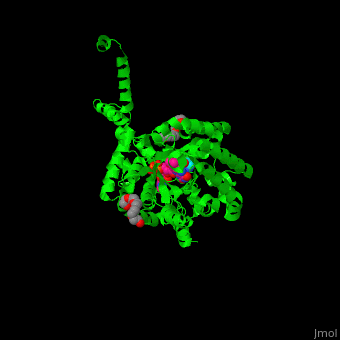FunctionProline utilization A (PutA) or bifunctional protein PutA is a bifunctional flavoprotein which acts as a transcriptional repressor of the put regulon or as a membrane-bound enzyme which catalyzes the oxidation of proline to glutamate. PutA domains include the DNA-binding domain (PRODH), the FAD-dependent proline dehydrogenase domain and the D-pyrroline-5-carboxylate dehydrogenase domain. The binding of proline to the PRODH active site and subsequent reduction of FAD causes a conformation change in PutA and enhance its membrane affinity. As a membrane-bound protein PutA switches from its repressor activity to its enzymatic role[1].
Structural highlightsThe . Water molecules are shown as red spheres. The 3e2q structure displayed here contains the [2].
| |
3D Structures of proline utilization A3D Structures of proline utilization A
Updated on 01-February-2022
{"openlevels":0}
- PutA
- 4nm9 – GsPutA + FAD – Geobacter sulfurreducens
- 7na0 – GsPutA (mutant) + FAD
- 4nma – GsPutA + FAD + tetrahydrofuran derivative
- 2gpe – EcPutA DNA-binding domain
- 2ay0 – EcPutA DNA-binding domain (mutant)
- 4q71, 4q72, 4q73 – BdPutA (mutant) + FAD – Bradyrhizobium diazoefficiens
- 4h6r – DrPutA + FAD – Deinococcus radiodurans
- 2gpe - EcPutA DNA-binding domain - Escherichia coli
- 2jxg, 2jxh - PpPutA DNA-binding domain - Pseudomonas putida - NMR
- 6ufp, 6vz9 – SmPutA (mutant) + FAD – Sinorhizobium melioli
- PutA complex
- 4nmb – GsPutA + FAD + lactate
- 4nmc – GsPutA + FAD + zwittergent
- 4nmd – GsPutA + FAD + dithionite
- 4nme – GsPutA + FAD + propargylglycine
- 4nmf – GsPutA + FAD derivative + menadione bisulfite
- 1tiw – EcPutA PRODH domain + FAD + tetrahydrofuran derivative
- 3e2r, 4jny, 4jnz – EcPutA PRODH domain (mutant) + FAD + tetrahydrofuran derivative
- 1tj0, 1tj1 – EcPutA PRODH domain + FAD + lactate
- 1tj2 – EcPutA PRODH domain + FAD + acetate
- 2fzn – EcPutA PRODH domain + FAD + proline
- 3e2q, 3e2s – EcPutA PRODH domain (mutant) + FAD + proline derivative
- 2fzm – EcPutA PRODH domain + FAD + SO2
- 3itg – EcPutA PRODH domain + FAD + propargylglycine
- 2rbf – EcPutA DNA-binding domain + DNA
- 4o8a – EcPutA DNA-binding + PRODH domains + FAD
- 4h6q – DrPutA + FAD + THF
- 3haz - PutA + FAD + NAD - Bradyrhyzobium japonicum
- 5ux5 - PutA + FAD + NAD - Corynebacterium freiburgense
- 5kf6, 5kf7, 6ufp, 6vz9 - PutA + FAD + NAD + THF - Sinorhizobium meliloti
- 2jxi - PpPutA DNA-binding domain + DNA
- 5ur2 - PutA + FAD derivative + inhibitor - Bdellovibrio bacteriovorus
- 6x9a, 6x9b, 6x9c, 6x9d – SmPutA + FAD + proline derivative
- 6x99 – SmPutA + FAD + Glu derivative
- 7my9, 7mya, 7myb, 7myc – SmPutA + FAD + dithiolane
- 6bsn – BdPutA + FAD + proline
ReferencesReferences
- ↑ Srivastava D, Zhu W, Johnson WH, Whitman CP, Becker DF, Tanner JJ. The Structure of the Proline Utilization A Proline Dehydrogenase Domain Inactivated by N-Propargylglycine Provides Insight into Conformational Changes Induced by Substrate Binding and Flavin Reduction (,). Biochemistry. 2009 Dec 29. PMID:19994913 doi:10.1021/bi901717s
- ↑ Ostrander EL, Larson JD, Schuermann JP, Tanner JJ. A Conserved Active Site Tyrosine Residue of Proline Dehydrogenase Helps Enforce the Preference for Proline over Hydroxyproline as the Substrate (dagger) (double dagger). Biochemistry. 2009 Feb 10;48(5):951-9. PMID:19140736 doi:10.1021/bi802094k
